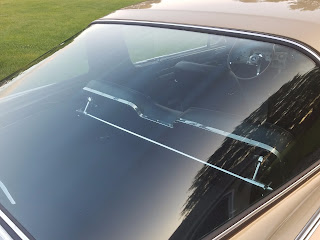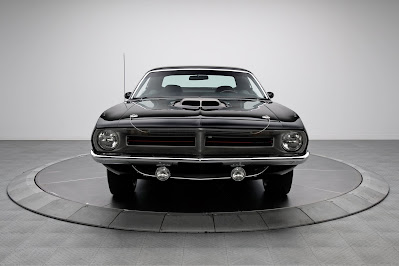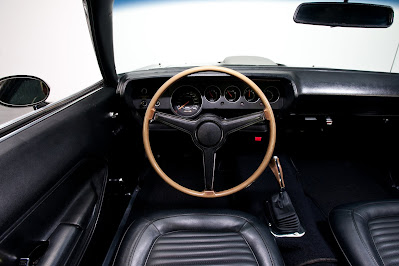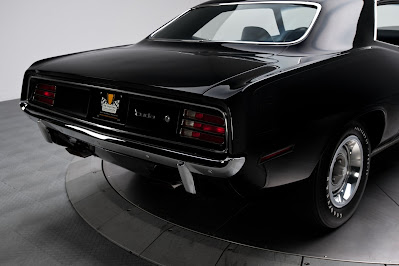Knock-knock. Who's there? Nostalgia. Again. The family next door to my family and I back on Long Island had a light green, four-door, 1964 Buick LeSabre so my interest in this 1964 Buick Wildcat is a bit of a stroll down the block I grew up on in Baldwin, New York for me since these '64 Wildcats and LeSabre's are so similar looking. Baldwin, incidentally, where I grew up, is on Long Island and is a bedroom community of Manhattan that, without traffic, is just twenty minutes or so from Times Square. Baldwin's now a community with housing so expensive that for the same kind of money a falling-down lean-to goes for there, like the pre-war dump I grew up in, you can buy a lavish, freshly built McMansion in most any mid-western city. But I digress.
Thursday, February 25, 2021
1964 Buick Wildcat - Knock-knock. Who's There?
Friday, February 19, 2021
Plymouth Barracuda - Dig This
My recent critically acclaimed and award-winning soliloquy (no one fact checks anymore, right?) about the 1971 film "Vanishing Point" and the 1970 Dodge Challenger R/T featured in it reminded me I'm way over due in blogging about the '70 Challenger's stablemate, the also new for 1970 Plymouth Barracuda. Grab your tie-dye and bell bottoms and let's get at it.
Of course, I can't leave well enough alone - I have to include a history (below) of the Barracuda's that came before the mighty 1970 rendition. Let's also back off the aquarium tank and acknowledge the Plymouth pony car's namesake which is a predatory, salt-water fish. Adorable, no? Might as well have named the car the Plymouth Piranha; the alliteration sounds catchier too.
A "barracuda" is also a less than flattering slang for a sexually aggressive woman or someone behaving underhandedly. The mighty Wilson sisters 1977 rock anthem paying homage to such people and behavior and not the fish or Chrysler built automobiles. Thank goodness the Plymouth Barracuda was long gone by the time this song came out; who knows what cheesy commercials would have been made using the song as an underscore. Gosh, those first couple of Heart albums where fabulous where they not?
Born into the murky waters of a market segment that had yet to be defined, the Plymouth Barracuda faced more problems than just a questionable namesake. The original debuted on, of all days, April Fool's Day, 1964 which was, notably, a good two-weeks plus ahead of Ford's debut of the Mustang. It was all downhill or upstream from there.
The original Barracuda, based on Chrysler's capable compact "A-body" chassis, was actually branded as a Plymouth Valiant Barracuda and perhaps done-so by the product-planning and marketing team that branded the 1960 Valiant as a "Valiant by Chrysler" and not as a Plymouth Valiant. That transgression quickly rectified come model year 1961. Chrysler dropped the Valiant pre-fix for 1965 and they, wisely, never brought it back.
The only tangible difference between a Valiant and a Valiant Barracuda was this gigantic rear windshield, or "back-light". Chrysler partnered with Pittsburgh Plate Glass to fabricate this thing that was and remains the largest piece of automotive glass ever produced. Nothing if not distinctive, it added approximately one-hundred pounds to the curb weight of a Valiant and was heavily tinted so as not to turn the insides of the air-conditioning free Valiant, err, Barracuda, into a greenhouse or sauna. Aside from that, the '64 Valiant Barracuda was all Valiant. Well, save for the availability of a high-performance version of Plymouth's 273 cubic-inch V-8 engine on Formula S models. For 1965 and beyond, Barracuda was a separate model from the Valiant even if it stayed looking like a Valiant with a huge rear window. You wouldn't be alone in thinking the design somewhat attractive if not cool while also being cluttered and awkward.
Unlike what Ford was able to do with their Falcon based Mustang, purportedly, what with millions spent and lost on the abortive 1961 downsizing of Plymouth and Dodge models, Chrysler did not have the financial resources to fully develop the Barracuda into a uniquely styled automobile. The fact that the Barracuda was a lightly disguised Valiant along with Plymouth calling it a Valiant Barracuda for 1964 being the auspices that have been decided as being the circumstances that did in Barracuda; the thinking goes buyers were unable to decipher the car from the economy car based Valiant.
To make matters worse, Plymouth marketed the utility of the Barracuda what with its fold-down rear seat and generous cargo area afforded by the massive back-light. Can you mix business with pleasure? On paper, maybe, but rarely could you do so back then. Today's do-everything-well cross-over utilities are a different story but back then a practical sporty car was akin to taking mom along on a hot date. Although that hot date had a habit of balancing picnic baskets on her head.
Plymouth slogged on through 1966 with the Barracuda making minor styling updates to the Valiant based two-door as designers headed back to the drawing board. Less than one-hundred thousand 1964-1966 Barracuda's found buyers meanwhile Ford literally and figuratively ran all the way to the Mustang bank to the tune of more than a million sold during the same time.
It's easy to say that Plymouth should have come out with this car in 1964 and not what they came with instead.
Available in notch-back, convertible and fast-back with a smaller more conventional looking back-light like this, the 1967-1969 Barracuda was still A-body based underneath but featured all-new, unique sheet metal up top that was construed as a stylistic success. From some angles I'd concur; from others not so much.
However, sales were still disappointing with this generation of the Barracuda best sales year, 1967, below the best years of the 1964-1966 models. A large part of that was most likely due to a market segment that now included a redesigned Mustang and a version of it from sister division Mercury. Don't discount GM's world beating twin-ponies, the Chevrolet Camaro and Pontiac Firebird. The market for these types of cars may have increased and expanded but it could only so by so much. Choice, after all, is great for customers but terrible for business.
Seeing that by the late 1960's what had become known as "pony-cars" had became a lucrative market segment commanding thirteen percent of all vehicle sales, somewhat remarkably, Chrysler executives tried for a third time to make inroads with an all-new Barracuda for 1970. Have to hand it to Chrysler in those days, they were nothing if not diligent.
Which brings us to today's main attraction. Ladies and gentlemen, may I present the greatest looking muscle or pony car of all time, the 1970 Plymouth Barracuda.
If I thought that Chrysler should have come with the 1967 Barracuda in 1964, then Chrysler should have come with this car in 1967. I hate the word, "should" but sometimes no other word is appropriate,
Bigger in every way from 1964-1969 Barracuda's except in actual length, the 1970 Plymouth Barracuda and it's stable mate Dodge Challenger began their development. Chrysler starting with their intermediate "B-body" chassis that also underpinned the Plymouth Satellite and Dodge Coronet.
Essentially a mid-size car with a shortened wheelbase, the 1970 Barracuda was available in notch-back and convertible only; the fast-back design gone from the line up but lived on, somewhat, in a new "A-body" based design at Plymouth known as the Duster.
Subjective as it may be, my blog, my rules, pardner, what Chrysler came with in 1970 with the Barracuda was and remains, to me at least, one of the greatest looking automobiles of all-time. Note I said "looking".
Curiously, the story goes that Chrysler did little suspension work on these believing that as fast as the cars where, if they could handle well it would have been even more dangerous. Makes no sense now, of course, as a high-performing car is actually a safer car. Well, usually. If you've ever had a car that was fast as hell but handled poorly, you know how quickly that gets old. As they say, it's much more fun to drive a slow car fast than drive a fast car fast.
That was too bad given how spectacular the design was and how well they could go in a straight line. The 1970 and 1971 models with Chrysler's mighty 440 cubic-inch V-8 in particular. The "Hemi" models as well but I'm of the opinion that the 440 engine was a better day-in, day-out street engine than the street-legal race engine that was the Hemi. "Legendary" doesn't always mean "good". I'd also opt for a 'cuda with the 340 "Six-Pack" but that's just me. Again, power is over-rated; it's control you want. Well, power and control.
Wouldn't you know it, though? Sales of these-generation Barracuda's, while better in 1970 compared to 1969 models, were extremely disappointing. Approximately fifty-five thousand found buyers in 1970; Dodge sold more than seventy-six thousand Challenger buyers but it's been said those sales came out of the bumpers of Charger sales and not Barracuda's. I know, weird but that's what they (der experts) say. . Barracuda sales dropped to around an abysmal eighteen-thousand for 1971, 1972 and 1973 sales hovered around a twenty-two thousand. In 1974, the model year most affected by the 1973 OPEC embargo, less than twelve-thousand Barracuda's left dealer lots.
Also, to use a vernacular of the times, "dig-this"; if you were of the age and of the means to buy a sporty compact in 1970, what with the gaggle of makes of models available to you, which one, all things being equal and you wanting the best car for your money, would you buy? Keep in mind GM's Camaro and Firebird were freshly updated and were gorgeous and performed better overall and the 1970 Mustang and Cougar were updated as well. You also had a Plymouth Duster that handled better and went like stink when optioned with the right go-fast engines. Choices. Choices. Too many choices, actually. Remember what I said about choices.
An all-new Barracuda was planned for 1975 but Chrysler didn't move forward with it seeing the automobile market was changing so quickly. 1974 was the last model-year for Plymouth's fish-car with approximately just one-hundred fifteen thousand "third-generation" models sold.
Ironically, 1970-1974 Plymouth Barracuda's, especially the 1970 and 1971 models, more than likely due to their scarcity and the fickle nature of the collector car market, have become some of the most sought after and valuable cars of this era.
Monday, February 15, 2021
Vince Lombardi's Pontiac's - More Than Just X's and O's
The tell-all it's a '68 is the chrome trim around the front end. 1965 models had stacked headlights, '66's had body-colored trim where the '68's have chrome. Also, obviously, seeing this footage was shot on December 31, 1967, it couldn't have been any newer than a 1968 model.

















































